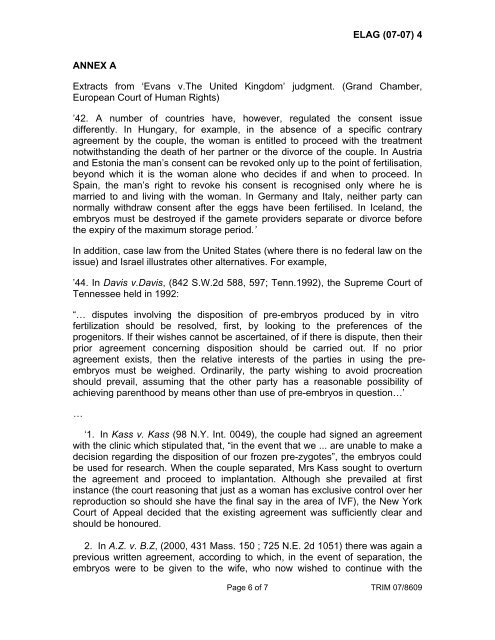ELAG (07-07) 4ANNEX AExtracts from ‘Evans v.The United Kingdom’ judgment. (Grand Chamber,European Court of Human Rights)’42. A number of countries have, however, regulated the <strong>consent</strong> issuedifferently. In Hungary, <strong>for</strong> example, in the absence of a specific contraryagreement by the couple, the woman is entitled <strong>to</strong> proceed with the treatmentnotwithstanding the death of her partner or the divorce of the couple. In Austriaand Es<strong>to</strong>nia the man’s <strong>consent</strong> can be revoked only up <strong>to</strong> the point of fertilisation,beyond which it is the woman alone who decides if and when <strong>to</strong> proceed. InSpain, the man’s right <strong>to</strong> revoke his <strong>consent</strong> is recognised only where he ismarried <strong>to</strong> and living with the woman. In Germany and Italy, neither party cannormally withdraw <strong>consent</strong> after the eggs have been fertilised. In Iceland, the<strong>embryos</strong> must be destroyed if the gamete providers separate or divorce be<strong>for</strong>ethe expiry of the maximum s<strong>to</strong>rage period.’In addition, case law from the United States (where there is no federal law on theissue) and Israel illustrates other alternatives. For example,’44. In Davis v.Davis, (842 S.W.2d 588, 597; Tenn.1992), the Supreme Court ofTennessee held in 1992:“… disputes involving the disposition of pre-<strong>embryos</strong> produced by in vitrofertilization should be resolved, first, by looking <strong>to</strong> the preferences of theprogeni<strong>to</strong>rs. If their wishes cannot be ascertained, of if there is dispute, then theirprior agreement concerning disposition should be carried out. If no prioragreement exists, then the relative interests of the parties in using the pre<strong>embryos</strong>must be weighed. Ordinarily, the party wishing <strong>to</strong> avoid procreationshould prevail, assuming that the other party has a reasonable possibility ofachieving parenthood by means other than <strong>use</strong> of pre-<strong>embryos</strong> in question…’…‘1. In Kass v. Kass (98 N.Y. Int. 0049), the couple had signed an agreementwith the clinic which stipulated that, “in the event that we ... are unable <strong>to</strong> make adecision regarding the disposition of our frozen pre-zygotes”, the <strong>embryos</strong> couldbe <strong>use</strong>d <strong>for</strong> research. When the couple separated, Mrs Kass sought <strong>to</strong> overturnthe agreement and proceed <strong>to</strong> implantation. Although she prevailed at firstinstance (the court reasoning that just as a woman has exclusive control over herreproduction so should she have the final say in the area of IVF), the New YorkCourt of Appeal decided that the existing agreement was sufficiently clear andshould be honoured.2. In A.Z. v. B.Z, (2000, 431 Mass. 150 ; 725 N.E. 2d 1051) there was again aprevious written agreement, according <strong>to</strong> which, in the event of separation, the<strong>embryos</strong> were <strong>to</strong> be given <strong>to</strong> the wife, who now wished <strong>to</strong> continue with thePage 6 of 7 TRIM 07/8609
ELAG (07-07) 4treatment, contrary <strong>to</strong> the wishes of the husband. However, the Supreme Cour<strong>to</strong>f Massach<strong>use</strong>tts considered that the arrangement should not be en<strong>for</strong>cedbeca<strong>use</strong>, inter alia, as a matter of public policy “<strong>for</strong>ced procreation is not an areaamenable <strong>to</strong> judicial en<strong>for</strong>cement”. Rather, “freedom of personal choice inmatters of marriage and family life” should prevail.3. This judgment was cited with approval by the Supreme Court of NewJersey, in J.B. v. M.B. (2001 WL 909294). Here, it was the wife who sought thedestruction of the <strong>embryos</strong> while the husband wanted them either <strong>to</strong> be donated<strong>to</strong> another couple or preserved <strong>for</strong> <strong>use</strong> by him with a future partner. Althoughconstitutional arguments were advanced on behalf of the wife, the court declined<strong>to</strong> approach the matter in this way, reasoning that it was in any event not surethat en<strong>for</strong>cing the alleged private contract would violate her rights. Instead,having taken in<strong>to</strong> account the fact that the father was not infertile, the courtsubscribed <strong>to</strong> the view taken in the A.Z. case regarding public policy and orderedthat the wife's wishes be observed.4. Finally, in Li<strong>to</strong>witz v. Li<strong>to</strong>witz, (48 P. 3d 261, 271) the woman, who had hadchildren be<strong>for</strong>e undergoing a hysterec<strong>to</strong>my, wished <strong>to</strong> <strong>use</strong> <strong>embryos</strong> created withher ex-husband's <strong>sperm</strong> and donor eggs <strong>for</strong> implantation in a surrogate mother.The ex-husband, however, wished the <strong>embryos</strong> <strong>to</strong> be donated <strong>to</strong> another couple.At first instance and on appeal the husband's view prevailed, but in 2002 theSupreme Court of Washing<strong>to</strong>n decided by a majority <strong>to</strong> adopt a contractualanalysis and <strong>to</strong> honour the couple's agreement with the clinic not <strong>to</strong> s<strong>to</strong>re the<strong>embryos</strong> <strong>for</strong> more than five years.3. Israel5. In Nachmani v. Nachmani (50(4) P.D. 661 (Isr)) a childless Israeli coupledecided <strong>to</strong> undergo IVF and then <strong>to</strong> contract with a surrogate in Cali<strong>for</strong>nia <strong>to</strong> beartheir child beca<strong>use</strong> the wife would not be able <strong>to</strong> carry the foetus <strong>to</strong> term. Thecouple signed an agreement with the surrogate, but not with the IVF clinicregarding the disposal of the <strong>embryos</strong> in the event of their separation. The wifehad her last eleven eggs extracted and fertilised with her husband's <strong>sperm</strong>. Thecouple then separated, be<strong>for</strong>e the <strong>embryos</strong> could be implanted in the surrogate,and the husband, who had gone on <strong>to</strong> have children with another woman,opposed the <strong>use</strong> of the <strong>embryos</strong>.The District Court found in favour of the wife, holding that the husband couldno more withdraw his agreement <strong>to</strong> have a child than a man who fertilises hiswife's egg through sexual intercourse. A five-judge panel of the Supreme Courtreversed this decision, upholding the man's fundamental right not <strong>to</strong> be <strong>for</strong>ced <strong>to</strong>be a parent. The Supreme Court reheard the case as a panel of eleven judgesand decided, seven <strong>to</strong> four, in favour of the wife. Each judge wrote a separateopinion. The judges in the majority found that the woman's interests and inparticular her lack of alternatives <strong>to</strong> achieve genetic parenthood outweighedthose of the man. Three of the minority judges, including the Chief Justice,reached the opposite conclusion, emphasising that the wife had known that herPage 7 of 7 TRIM 07/8609
















